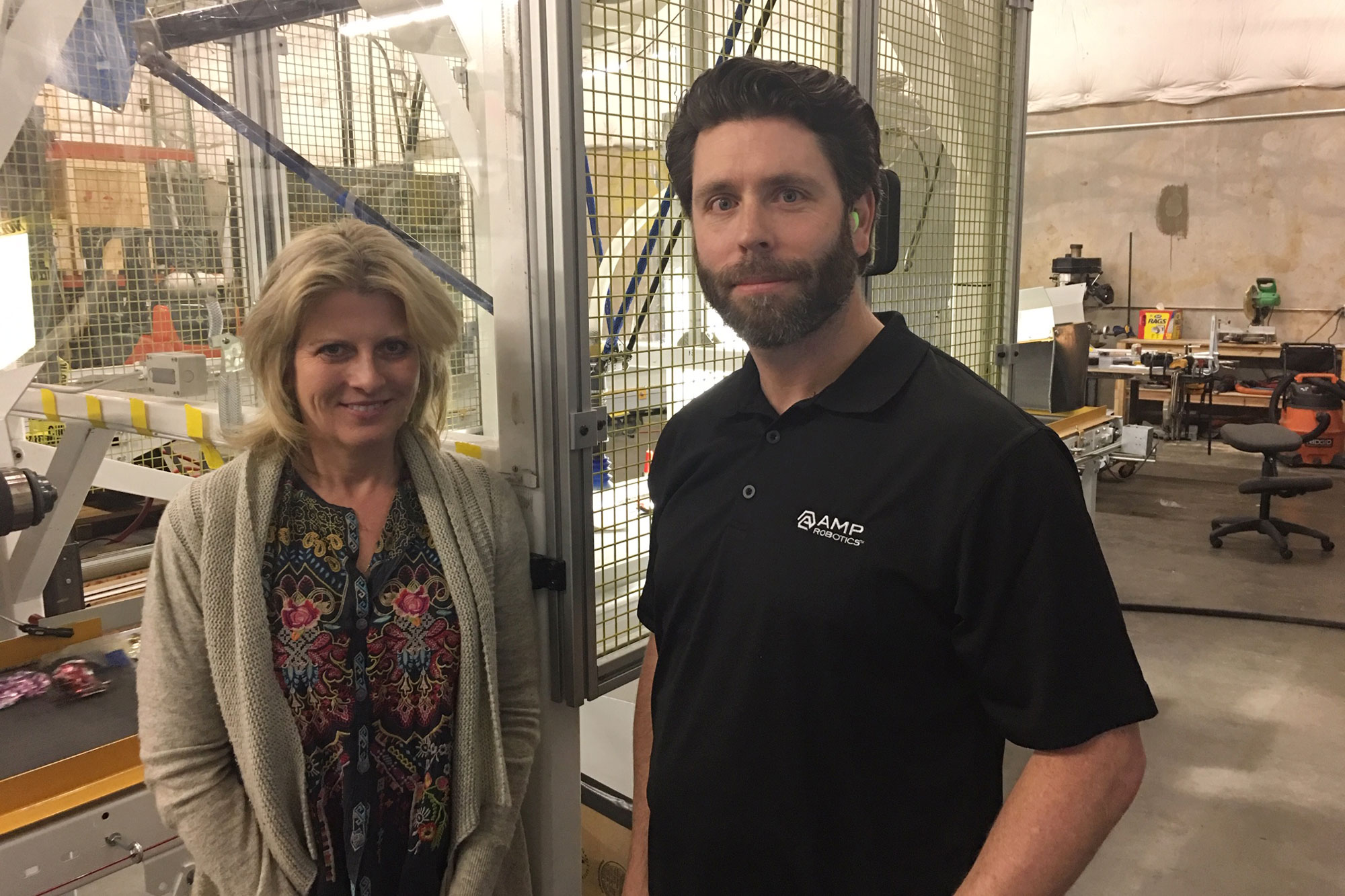
For as long as there have been robots, there’s been the fear that they will take our jobs, or even worse — take over everything.
Well, reality is more nuanced than most Sci-Fi movies’ depiction of artificial intelligence. Industry officials say it’s less about replacing people in jobs, but more about giving them extra tools to make work and life easier.
Robots In Recycling
Clarke, an artificially intelligent robot, works at Alpine Waste & Recycling in Denver.
His job is to identify certain types of material, pluck that off the conveyor belt and put the material into a designated bin. Clarke identifies the material using eyes very similar to human ones. He processes patterns and colors like we would and is always learning new ones, said his creators at AMP Robotics.
AMP is based in Louisville, Colo. and makes artificially intelligent robots like Clarke to deal with municipal waste, electronic waste and construction demolition. The company’s director of operations, Rob Writz, said the technology behind the robots’ eyes is even similar to human biology.
“We use what we call artificial neural networks to identify the material,” Writz said. “This operates off this vast series of examples, these visual examples, that we have fed into these neural networks with our own process to teach them what the crumpled, folded, distorted materials are in the waste stream.”

The most challenging thing for AMP’s robots to learn is the difference between all those colorful cartons you find in the grocery store. There are a lot of variations when it comes to milk, juice, half and half, or broth cartons.
But what does AMP’s technology mean for those working in the recycling and waste industry? Writz doesn’t think the robots will be putting many people out of work since a lot of those jobs are already unfilled or experience high turnover.

“It’s a very dangerous, dirty and often dull job and so they have a difficulty actually staffing,” he said. “Some often measure their turnover in a matter of weeks.”
For the people that do stick it out, Writz thinks more robots in facilities could mean promotions for those workers.
“What we have seen with our customers so far is that those people are then allocated into a much higher value role in the facility,” Writz said. “[Like] working with these robots, learning the skills to maintain them, keep them going.”
Writz has no doubt humans will always have a place in the recycling and waste industry but he thinks they might not always be the smartest workers in the room.
“It’s going to know the waste stream better than any person,” he said. “As I mentioned earlier, there is a lot of turnover in the sorting jobs in these facilities. That is knowledge lost every time someone leaves. Because even when a human comes in, they have to be trained and taught.”
But before the fear of a robot takeover sets in, Writz assured that these robots are only experts in what they’re exposed to. It’s unlikely they would ever learn anything beyond the recycling world. Plus, they’re bolted to the ground.
Robots In Fast Food
Holly, made by Valyant A.I., is a disembodied voice that takes drive-through orders at a Good Times in South Denver.
The Colorado fast food chain started experimenting with conversational A.I. to lighten the load of some of its employees who often juggle multiple tasks at the same time. Rob Carpenter, founder of Valyant A.I., said the hospitality industry needs robots right now to make up for the lack of applicants.
“In the United States, because it’s such a tight labor market, there’s somewhere in the neighborhood of 800,000 unfilled positions,” Carpenter said.

Holly is similar to other voice systems like Alexa or Siri, but she specializes in the language of fast food — something that’s not as straightforward as it sounds.
“The biggest challenges to these types of models is nobody orders food the same way,” Carpenter said. “Think of soda, or pop, or Coke. In one region, Coke could be referring to I want a soft drink. In another region, Coke refers to a very specific product.”
Carpenter added that his technology is only automating one task out of a slew of other tasks that will be performed by humans. But he does admit the automation of one task will still inevitably lead to less positions.
“Now if you looked over an entire organization, will that reduce some of the work and some of the need for labor?” he said. “It would be disingenuous to say no.”
Robots In Your Home
Misty Robotics in Boulder wants to build “the robot for everyone” and put one in every home and office.
What could the benefit of that be? Ian Bernstein, the company’s founder, said there’s a lot of opportunity for robots to help with simple tasks in our everyday lives. But there’s also the potential for them to help the elderly and disabled in big ways.
“Our CEO has a personal mission to eliminate nursing homes,” Bernstein said. “He doesn’t want to see his mom go into a nursing home when she gets old, where robots could take care of her at home. I think the quality of life of older people could become much better with robots in the future.”
Bernstein believes help with simple tasks can make a big difference — even as simple as getting a glass of water. He described how after he tore his ACL in December and was on crutches for two weeks, the simplest of tasks became major productions.
“Just a robot that could do that for me, and of course that was just two weeks,” he said. “There’s a lot of people out there with disabilities. Like that’s a huge thing, just to carry a glass of water and follow you.”
What The Future Holds
With robots shifting the workplace and even how we do things at home, there’s no question that the world will operate very differently in 50 years.
Thomas Frey, a futurist and founder of the DaVinci Institute in Westminster, had an alternate answer to whether there will be less jobs in the future because of this shift.
“Actually I think it creates the opportunity for more industries and more jobs,” Frey said. “I think we’re actually moving into an era of super-employment. I think we’re going to have more jobs than ever before in all history, it’s just that they won’t be full time jobs, they will be gigs.”
But the catch, Frey said? We aren’t prepared for the “Gig Economy.” Younger generations aren’t trained on how to freelance, he said.
Frey also believes there’s a cap on how much technology humans are willing to deal with. Take e-commerce for example — in 2018, 10 percent of all retail dollars came from online sales. Which might seem low 25 years into the Internet age and with the ongoing collapse of brick and mortar stores, Frey said. But he predicts that e-commerce will never be more than 20 percent of retail dollars simply because humans crave other humans.
“If you think about what 100 percent e-commerce would look like, that means that we have no place to go, we have no bars, no restaurants, we have no place to go out and be around other people,” he said. “As humans, we’re social creatures, we need to be around other people.”









